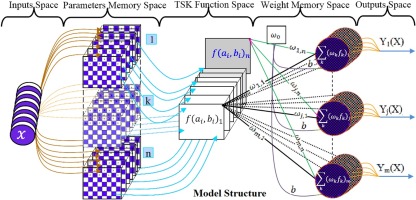Sustainable Cities and Society ( IF 11.7 ) Pub Date : 2020-02-14 , DOI: 10.1016/j.scs.2020.102091 Raad Z. Homod , Hussein Togun , Haider J. Abd , Khairul S.M. Sahari

|
the HVAC systems consume more than half of the total buildings energy demand, forecasting the cooling/heating load of the building is important to predict buildings energy demand. The energy assessment tools such as a model for forecasting building energy consumption is based on outdoor thermal conditions, the outdoor conditions are highly nonlinear in real life cannot be represented by linear differential equations and have an uncertain disturbance nature. This paper contrives a novel nonlinear model structure to cope with such difficulty, which is composed of two hybrid nonlinear forms, Takagi-Sugeno fuzzy system (TS-FS) and Neural Networks’ Weights. Such a structure has many advantages, including suitability for multi-layer implementations like an integrated eight-dimension net of parameters and weights which represents model input-output relations of a nonlinear system. The Gauss-Newton algorithm is used to tune model weights and parameters for the fitting of nonlinear regression of clusters model to data. The main feature of the proposed model is to express the dynamic conditions of the outdoor thermal environment of each fuzzy implication by a cluster functions model and thus promote the prediction performance. The overall proposed model is tested on the training and validation of multizone then compared with the RLF model. The corresponding results show that a better hybrid modelling and uncertainty mitigation which is achieved without significant loss of prediction accuracy.
中文翻译:

利用Takagi-Sugeno模糊模型制作的新型混合建模结构,可实时预测巴士拉市的HVAC系统能源需求
HVAC系统消耗了建筑总能源需求的一半以上,因此预测建筑的冷/热负荷对预测建筑能源需求非常重要。诸如建筑能耗预测模型等能源评估工具是基于室外热条件的,室外条件在现实生活中是高度非线性的,无法用线性微分方程表示,并且具有不确定的干扰性质。本文设计了一种新颖的非线性模型结构来应对这种困难,它由两种混合非线性形式组成,即Takagi-Sugeno模糊系统(TS-FS)和神经网络的权重。这样的结构有很多优点,包括对多层实现的适用性,例如参数和权重的集成八维网络,代表非线性系统的模型输入输出关系。Gauss-Newton算法用于调整模型权重和参数,以将聚类模型的非线性回归拟合到数据。该模型的主要特征是通过聚类函数模型表达每个模糊蕴涵的室外热环境的动态条件,从而提高了预测性能。提出的总体模型在多区域的训练和验证上进行了测试,然后与RLF模型进行了比较。相应的结果表明,可以实现更好的混合建模和不确定性缓解,而不会显着降低预测精度。Gauss-Newton算法用于调整模型权重和参数,以将聚类模型的非线性回归拟合到数据。该模型的主要特征是通过聚类函数模型表达每个模糊蕴涵的室外热环境的动态条件,从而提高了预测性能。提出的总体模型在多区域的训练和验证上进行了测试,然后与RLF模型进行了比较。相应的结果表明,可以实现更好的混合建模和不确定性缓解,而不会显着降低预测精度。Gauss-Newton算法用于调整模型权重和参数,以将聚类模型的非线性回归拟合到数据。该模型的主要特征是通过聚类函数模型表达每个模糊蕴涵的室外热环境的动态条件,从而提高了预测性能。提出的总体模型在多区域的训练和验证上进行了测试,然后与RLF模型进行了比较。相应的结果表明,可以实现更好的混合建模和不确定性缓解,而不会显着降低预测精度。该模型的主要特征是通过聚类函数模型表达每个模糊蕴涵的室外热环境的动态条件,从而提高了预测性能。提出的总体模型在多区域的训练和验证上进行了测试,然后与RLF模型进行了比较。相应的结果表明,可以实现更好的混合建模和不确定性缓解,而不会显着降低预测精度。该模型的主要特征是通过聚类函数模型表达每个模糊蕴涵的室外热环境的动态条件,从而提高了预测性能。提出的总体模型在多区域的训练和验证上进行了测试,然后与RLF模型进行了比较。相应的结果表明,可以实现更好的混合建模和不确定性缓解,而不会显着降低预测精度。



























 京公网安备 11010802027423号
京公网安备 11010802027423号